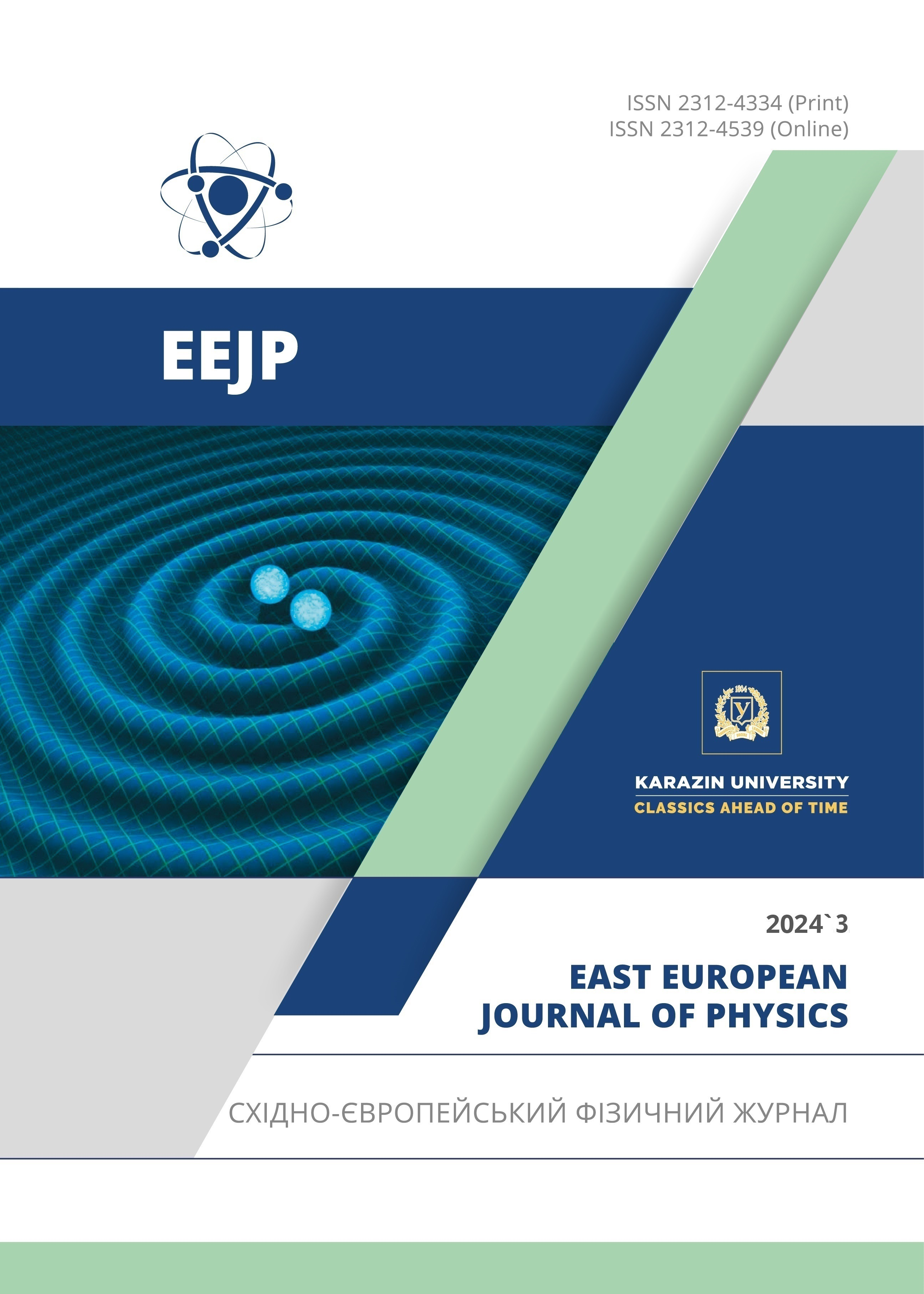Method of Digital Processing of Optical Spectra of Magnetron Discharge Plasma
Abstract
To solve the actual problems associated with the development of the theory of magnetron discharge and the expansion of its practical application, a digital method of recording and processing the discharge plasma luminescence spectra is proposed in this work. To obtain the discharge plasma glow spectra, a photographic technique was used, which allowed simultaneous recording of the entire radiation spectrum in the 390.0-700.0 nm region. An additional advantage of this technique is the ability to track spatial changes in the composition and properties of the plasma in the discharge in the selected direction. A Canon EOS 80D digital camera with remote control was used to record the optical signal. A graphical application OSA was created to process digital images of the discharge plasma luminescence spectra. The paper describes the functionality of this application: determination of the wavelength of a spectral line and its belonging to a certain chemical element; measurement of the spatial distribution of the intensity of a spectral line along the selected direction of radiation registration. Determining the wavelength of a spectral line in the application is possible in two modes of operation - automatic and manual. In the first mode, the algorithm developed in this paper determines the wavelength for all spectral lines whose intensity exceeds the background value at a height of 10 % of the lower spectral limit. The second mode allows you to independently select a single spectral line or several to determine their wavelengths. The first mode is used for quick analysis, while the second mode allows you to determine the length of the spectral line with greater accuracy. To interpret the spectral lines, the methodology of reference lines from the databases of spectral line tables for various elements is used. The possibility of both full automatic verification, where all elements are sequentially searched, and selective verification, where one or more elements are selected, is provided. The paper shows that the spatial distribution of the intensity of tungsten spectral lines, and thus of excited atoms in a magnetron discharge, is a complex function of the distance from the cathode, which depends on the discharge parameters. The proposed digital methodology makes it possible to significantly speed up the process of obtaining physical information and increase the accuracy in determining the spectrum parameters.
Downloads
References
Yong Hua, Chaozheng Zhou, Yanhuai Li, Liuquan Yang, and Zhongxiao Song, Corrosion Science, 196, 110020 (2022), https://doi.org/10.1016/j.corsci.2021.110020.
Hicham Larhlimi, Anas Ghailane, Mohammed Makha, and Jones Alami, Vacuum, 197, 110853 (2022), https://doi.org/10.1016/j.vacuum.2021.110853.
Muhammad Qadir, Yuncang Li, and Cuie Wen, Acta Biomaterialia, 89, 14 (2019), https://doi.org/10.1016/j.actbio.2019.03.006
W.D. Sproul, M.E. Graham, M.S. Wong, S. Lopez, and D. Li, Journal of Vacuum Science and Technology A: Vacuum, Surfaces and Films, 13, 1188 (1995), https://doi.org/10.1116/1.579859
G. Wisz, P. Sawicka-Chudy, A. Wal, P. Potera, M. Bester, D. P loch, M. Sibi´nski, M. Cholewa, and M. Rusza la, Applied Materials Today, 29, 101673 (2022),https://doi.org/10.1016/j.apmt.2022.101673
U. Fantz, Plasma Sources Sci Technol., 15, S137 (2006), https://doi.org/10.1088/0963-0252/15/4/S01
X.M. Zhu, and Y.K. Pu, J. Phys. D. Appl. Phys., 43, 403001 (2010), https://doi.org/10.1088/0022-3727/43/40/403001
A. Murmantsev, A. Veklich, V. Boretskij, A. Shapovalov, and A. Kalenyuk, Plasma Physics and Technology, 6, 87 (2019), https://doi.org/10.14311/ppt.2019.1.87
Himanshu Mishra, Milan Tich´y, and Pavel Kudrna, Vacuum, 205, 111413 (2022), https://doi.org/10.1016/j.vacuum.2022.111413
Eisuke Yokoyama, Masaomi Sanekata, Nobuo Nishimiya, Masahide Tona, Hiroaki Yamamoto, Keizo Tsukamoto, Kiyokazu Fuke, Keijiro Ohshimo and Fuminori Misaizu, Jpn. J. Appl. Phys., 62, SL1008 (2023), https://doi.org/10.14311/ppt.2019.1.87
I.A. Afanasieva, S.N. Afanasiev, N.A. Azarenkov, V.V. Bobkov, V.V. Gritsyna, Yu.E. Logachev, I.I. Okseniuk, A.A. Skrypnyk, D.I. Shevchenko, and V.M. Chornous, Problems of Atomic Science and Technology, 2, 164 (2019), https://vant.kipt.kharkov.ua/TABFRAME1.html
I.A. Afanasieva, S.N. Afanasiev, V.V. Bobkov, V.V. Gritsyna, D.R. Drozdov, Yu.E. Logachev, A.A. Skrypnyk, and D.I. Shevchenko, Problems of Atomic Science and Technology, 4, 35 (2019), https://vant.kipt.kharkov.ua/TABFRAME1.html
I.A. Afanasieva, V.V. Bobkov, V.V. Gritsyna, Yu.E. Logachev, I.I. Okseniuk, A.A. Skrypnyk, and D.I. Shevchenko, Vacuum, 149, 124 (2018), https://doi.org/10.1016/j.vacuum.2017.12.027
V.I. Malyshev, Vvedenie v jeksperimental’nuju spektroskopiju. (Nauka, Moskva, 1979), pp. 480.
Mark Lutz, Learning Python, Fifth Edition. (“O’Reilly Media”, 2013), pp. 1594.
Copyright (c) 2024 Inna Afanasieva, Serhii Afanasiev, Valentin Bobkov, Valentina Gritsyna, Anatoliy Skrypnyk

This work is licensed under a Creative Commons Attribution 4.0 International License.
Authors who publish with this journal agree to the following terms:
- Authors retain copyright and grant the journal right of first publication with the work simultaneously licensed under a Creative Commons Attribution License that allows others to share the work with an acknowledgment of the work's authorship and initial publication in this journal.
- Authors are able to enter into separate, additional contractual arrangements for the non-exclusive distribution of the journal's published version of the work (e.g., post it to an institutional repository or publish it in a book), with an acknowledgment of its initial publication in this journal.
- Authors are permitted and encouraged to post their work online (e.g., in institutional repositories or on their website) prior to and during the submission process, as it can lead to productive exchanges, as well as earlier and greater citation of published work (See The Effect of Open Access).








